Split Travel Guide
The pretty city of Split has a rich history. Since ancient times, it has served in various guises as the economic and administrative centre of the beautiful Croatian Adriatic coastal region, today called Dalmatia.
The city is mainly sprawled on a peninsula on the eastern part of the island of Ciovo, although it has spread onto the mainland and encompasses the mouth of the River Cetina. From the 5th to the 2nd century BC, Greek colonists settled the mainland and adjacent islands.
Later came the Romans, in particular the Emperor Diocletian. Being of Dalmatian origin, he elected to build a huge palace at a spot then called Salona in the year 303 AD. A town grew around the palace and by the Middle Ages, the city of Split had begun to develop.
Diocletian's Palace still stands in the very heart of the old quarter of Split, charming visitors with its cobbled streets and classical architecture. The greater region is characterised by lush vegetation and verdant greenery, particularly Marjan Hill on the west of the peninsula with its ancient indigenous forest.
The city makes an ideal base from which to explore the wondrous islands, beautiful locations and historic villages in central Dalmatia. Split is also world renowned among seafarers for the quality of its some 44 marinas, drawing yachts and catamarans from all over Europe and making it a great cruising destination in the Adriatic.
Things to do in Split
Split is an ancient and attractive city with centuries of history bolstering its modern appeal. As with many Croatian settlements, the richest concentration of tourist attractions in Split can be found in its oldest districts around the famous Diocletian's Palace. This magnificent building was constructed by the Roman Emperor Diocletian in 303 AD, and it's a privilege and a pleasure to explore. There are several informative walking tours through the palace complex and surrounding old areas.
The impressive Cathedral of St Domnius and a climb up its rather scary bell tower will often feature on these tours. Another experience not to be missed is the remarkable clock by West Gate, which has kept time in the city for more than a century.
There are lots of other things to see and do in Split, such as the oldest museum in Croatia: the Archaeological Museum. It collects and displays artefacts from the city's long history and is a joy for history buffs. On a more contemporary note, travellers will enjoy a stroll along the pretty promenade of Riva Harbour, lined with bars and spots for outside recreation.
Split is also a convenient base for excursions and day trips to myriad beautiful islands and villages: the nearby islands of Brac and Hvar offer stunning beaches and charming little towns, and the coastal villages of Makarska and Sibenik are enduring Croatian favourites. Lastly, the magical walled town of Trogir, a UNESCO World Heritage Site, is situated on a tiny island between Ciovo and the mainland, and tops the list of many a Croatian travel itinerary.
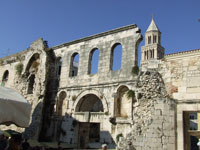
Diocletian's Palace
Diocletian's Palace is one of the world's most imposing ancient Roman structures. Built between the late third and early fourth centuries A.D., it is more than a palace or a museum. Rather, it is Split's living heart, where visitors will find the labyrinthine streets packed with people, bars, shops and restaurants. The palace was constructed as a combined imperial residence, military fortress and fortified town, and its original structure has been added to continuously over the millennia.
The Roman emperor, Diocletian, commisssioned the palace to be finished in time for his retirement in A.D. 305, sparing no expense in its construction. Over the course of 10 years he transported lustrous white stone from the island of Brac, marble from Italy and Greece, and also columns and 12 sphinxes from Egypt for the sake of his project.
These days, visitors can often hear music in the palace and should note that the setting is particularly attractive in the evenings. When the sun sets, the marble and granite columns are usually illuminated by colourful garlands, and the palace's interiors become stages for actors in Roman togas.
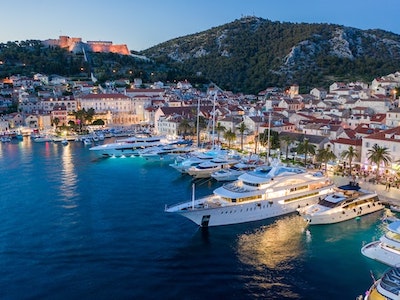
Hvar Island
The island of Hvar lies off the coast of Split and abounds with Romanesque and Renaissance buildings, and a true Mediterranean atmosphere. Inhabited since 3500 BC, it's now mainly a wine-growing area, with the main towns of Vrboska and Jelsa famed for their Dalmatian vintages. Hvar is dotted with picturesque rural villages, many fairly untouched by time and tourism. The incredible Hvar Fortress is one of the island's must-see attractions. Reached by a fairly strenuous climb, it offers exquisite views of the whole town and harbour. No trip to Hvar would be complete without a visit to Dubovica Beach, which is often delightfully free of crowds.
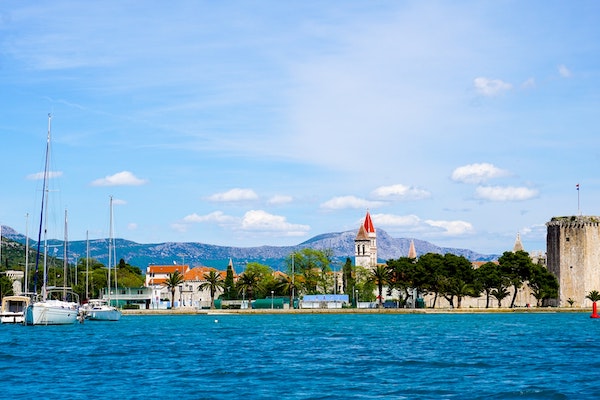
Trogir
The gorgeous historic town of Trogir is one of Split's most essential day trips. Set within medieval walls and connected to both the mainland and the island of Čiovo by bridges, this tiny island has retained many intact and beautiful buildings from its golden age between the 13th and 15th centuries. Today, it is a treasure trove of Renaissance and Baroque architecture, and Romanesque churches, and has deservedly been on the UNESCO list of World Heritage Sites since 1987. Summer nights are perfect for soaking up Trogir's laidback atmosphere, as everyone heads for the bars and cafes that line the wide seaside promenade.
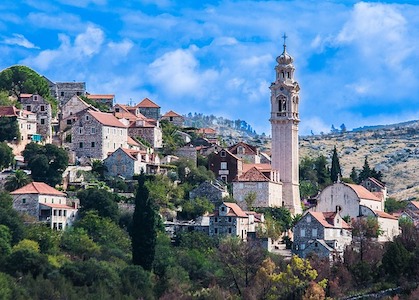
Brac Island
Bol and Supetar are the two main resorts on Brac, and have attractive old towns and laid-back charm. Brac is a great destination for a number of watersports, with Bol being the windsurfing capital of Croatia. It also boasts a famous strip of beach that stretches out into the ocean, featuring on most Croatian tourist brochures. Like much of Croatia, the beaches on Brac Island are mainly rocky, boasting stunningly clear blue water and calm seas. Those desperate to find a sandy beach should head down to Lovrecina, which has its own beach bar and restaurant. Brac is generally less crowded than Split and other popular areas on Croatia's mainland, but can get busy during the peak summer months.
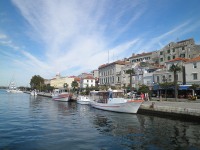
Sibenik
Sibenik is a historic town in central Dalmatia. Over the centuries, it has endured many rulers who have claimed it as their own, from Byzantium to the Kingdom of Bosnia. Naturally, it's a product of this complex past, with a diverse tapestry of influences and rich cultural heritage. Sibenik is home to the Cathedral of St Jacob, the crowning glory of the Dalmatian Coast. The beautiful baptistery, domed roof and 71 stone heads on the exterior walls truly make this Renaissance cathedral a thing of divine beauty. The city also makes a good base from which to visit the nearby Krka National Park.
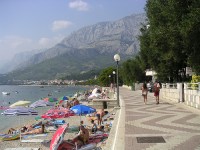
Makarska
Fringed by the two green peninsulas of Osejava and St Peter, Makarska's cobblestoned streets and natural harbour nestle in the shadow of Mount Biokovo. This beautiful town offers secluded beaches washed by an azure sea and lies at the heart of the Makarska Riviera, which is characterised by pine forests and a string of white pebble beaches. Makarska's history has included occupations by the Venetians, Turks, French and Austrians, who all left imprints of their own culture and tradition. The town boasts a 16th century Franciscan monastery, a Venetian fountain, several churches and Baroque palaces. The main tourist district is lined with fashionable boutiques, cafes and bars, all a stone's throw away from the yachts and catamarans docked in the harbour.
Getting Around
A popular tourist destination, Split provides travellers with a number of effective ways to get around town. Travellers in Split should find it easy to move seamlessly from one form of transport to the next, as the ferry, bus and train stations are all near one another.
The primary form of public transportation in Split is the city's bus network, which is extensive and covers all areas of the city that might be of interest to travellers. Buses usually run from about 5am until around midnight, and have their destinations clearly laid out in route maps at most stops. Visitors will find most of their travel needs attended to by the bus stop near the ferry harbour, as it's a meeting point of the most popular lines.
However, many travellers in Split may find it easiest and most enjoyable to simply get around on foot. The layout of the city is accommodating to pedestrians, with key attractions and shopping centres within walking distance and a scenic promenade along the water between the port and marina.
Visitors in Split also have the option of renting a car. This can be especially useful for those wanting to explore the surrounding area. Thankfully, Croatian roads are famously good. Although renting a car is ideal for exploring the wider region, prospective drivers should note that there isn't much parking in the city centre and none in Split's old town.
Split Climate and Weather
Split has a Mediterranean climate, with short, hot, and mostly clear summers, and winters that are long, cold, wet, windy, and partly cloudy. The hot season runs from June to September, and the average daily high temperature above 82F (30C). The cool season lasts from November to March; the average daily high is below 59F (15C). For travellers who are interested in hot-weather activities, the best time to visit Split is from late June to late August.
Croatia travel info
Electricity
Electrical current is 230 volts, 50Hz. European-style, round, two-pin plugs are standard.
Language
The official language is Croatian.
Money
The official unit of currency is the euro, which was introduced on 1 January 2023. ATMs are plentiful throughout the country and banks, authorised bureaux de change, post offices and most hotels exchange foreign currency. Banks open Monday to Saturday and some banks also open on Sundays in the main cities. Major credit cards are widely accepted at the main hotels and restaurants, and may be used to draw cash from ATMs, which are widely available throughout the country.
Tipping
A tip of 10 percent will be appreciated in tourist or upmarket restaurants, though it's common to simply round up the bill if the service has been good in other establishments. Tour guides expect to be tipped.
Health
The medical facilities and care in Croatia are fairly good, with free emergency medical care available to EU citizens with a European Health Insurance Card (EHIC). After Brexit, the Global Health Insurance Card (GHIC) replaced the European Health Insurance Card (EHIC) for UK citizens. The GHIC allows UK citizens access to state healthcare during visits to the EU. The GHIC is not valid in Norway, Iceland, Liechtenstein or Switzerland, nor is it an alternative to travel insurance. Non-EU nationals are advised to take out comprehensive travel insurance, and those who need particular medications should take the supply needed for the duration of their stay with them, plus a doctor's letter to get the items through customs.
Safety
Most visits to Croatia are trouble free. Crime levels are low and violent crime is rare but, as petty theft occurs in busy tourist areas, it's worth keeping a careful eye on valuables. Visitors should be vigilant when attending soccer matches and sports rallies, which sometimes lead to rowdy behaviour and violent incidents. Croatia is a popular party destination but partying carries safety, legal and financial risks. Nightclub fires, balcony collapses, and crowd crushes can occur; accidents resulting in serious injuries have taken place on party boats.
Local customs
It's prohibited or considered inappropriate to walk around cities and some town centres shirtless or in swimming costumes. In some places, such as parts of Dubrovnik, there is signage indicating that people are required to cover up and that fines will be imposed on those who don't comply. Even when there is no such signage, travellers are advised to be sensitive to local conventions and sensibilities.
Doing business
Business in Croatia tends to be quite formal. Punctuality is key, dress should be smart and handshakes are the preferred form of greeting. Titles and surnames are usually used unless otherwise indicated and business cards are often exchanged at the beginning of a meeting. English and German are widely spoken but any attempt at speaking some Croatian will be appreciated. Women frequently hold high positions in business and are well respected.
Building a good working relationship is important and it's useful to work with a reliable local partner. Although Croatia appears typically European in its dealings, business can take some time to conclude. Business hours are usually 8am to 4pm, Monday to Friday.
Duty free
Non-EU travellers to Croatia can enter the country with the following items without incurring customs duty: 200 cigarettes or 50 cigars or 250g of tobacco; 4 litres of wine, 1 litre of spirits and up to 16 litres of beer; and other goods up to the value of HRK 3,200 if arriving by air or HRK 2,200 if arriving by other means of transport.
Communications
The international access code for Croatia is +385 and WiFi availability is good.
Passport & Visa
All foreign passengers to Croatia must hold return or onward tickets and the necessary travel documentation for their next destination, as well as proof of sufficient funds (at least EUR 70 per day of stay, at least EUR 30 per day of stay if holding a confirmed invitation or a tourist voucher). It is highly recommended that travellers' passport have at least six months' validity remaining after the intended date of departure from their travel destination. Immigration officials often apply different rules to those stated by travel agents and official sources.
Entry requirements
US citizens must present a passport valid for three months beyond period of intended stay, and visas are not required for stays of up to 90 days. Visitors don't need to provide their Covid vaccination status for entry to Croatia.
UK nationals must have a passport valid for three months beyond the period of intended stay, and a visa is not required for up to 90 days. Visitors don't need to provide their Covid vaccination status for entry to Croatia.
Canadian citizens must have a passport valid for three months beyond period of intended stay in Croatia, and no visa is required for stays of up to 90 days. Visitors don't need to provide their Covid vaccination status for entry to Croatia.
Australian citizens must have a passport valid for three months beyond the period of intended stay in Croatia, and no visa is required for stays of up to 90 days. Visitors don't need to provide their Covid vaccination status for entry to Croatia.
South African nationals must have a passport valid for three months beyond the period of intended stay in Croatia and a visa is required, unless travellers already hold a multiple-entry Schengen C visa. Visitors don't need to provide their Covid vaccination status for entry to Croatia.
Irish nationals must have a passport valid for the period of intended stay in Croatia, and no visa is required. Visitors don't need to provide their Covid vaccination status for entry to Croatia.
New Zealand citizens must have a passport valid for three months beyond the period of intended stay in Croatia, and no visa is required for stays of up to 90 days. Visitors don't need to provide their Covid vaccination status for entry to Croatia.
Useful contacts
Croatian National Tourist Board, Zagreb: +385 (0)1 469 9333 or www.croatia.hr
112 (General Emergency Helpline)Embassies / consulates in other countries
Embassy of Croatia, Washington DC, United States: +1 202 588 5899.
Embassy of Croatia, London, United Kingdom: +44 (0)20 7387 2022.
Embassy of Croatia, Ottawa, Canada: +1 613 562 7820.
Embassy of Croatia, Canberra, Australia: +61 (0)2 6286 6988.
Embassy of Croatia, Pretoria, South Africa: +27 (0)12 342 1206.
Embassy of Croatia, Dublin, Ireland: +353 (0)1 476 7181
Consulate of Croatia, Auckland, New Zealand: +64 274 998850.
Embassies / consulates in Croatia
United States Embassy, Zagreb: +385 (0)1 661 2200.
British Embassy, Zagreb: +385 (0)1 600 9100.
Canadian Embassy, Zagreb: +385 (0)1 488 1200.
Australian Embassy, Zagreb: +385 (0)1 489 1200.
South African Embassy, Budapest (also responsible for Croatia): +36 1 392 0999
Embassy of Ireland, Zagreb: +385 (0)1 627 8920.
New Zealand Consulate, Rome, Italy (also responsible for Croatia): +39 06 853 7501.



